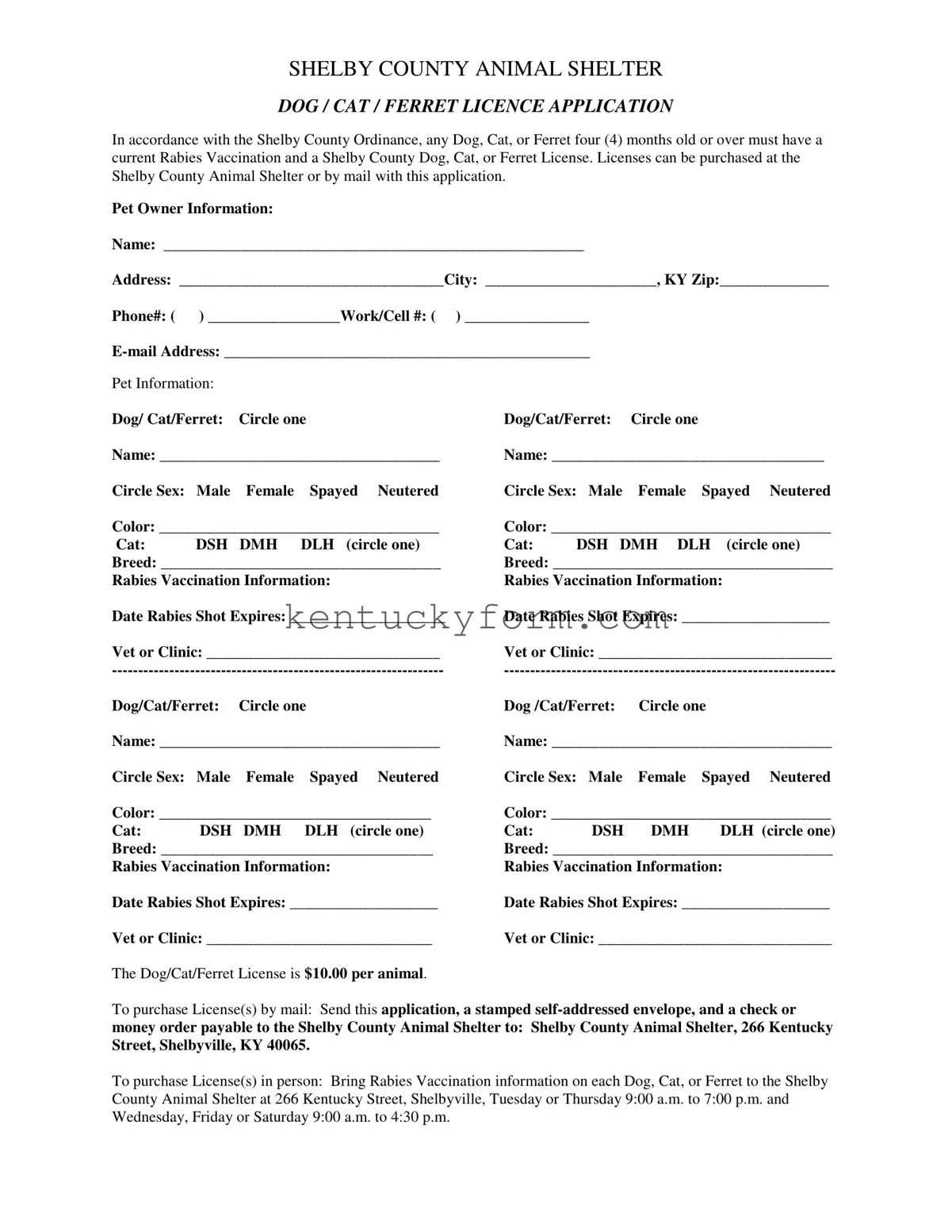The Kentucky Dog License Shelby County form shares similarities with pet adoption applications. Both collect detailed information about the pet, including name, sex, color, and breed. While the license application focuses on ensuring compliance with local laws, an adoption application evaluates the potential home environment. Each serves to record specific information related to the well-being and legal status of pets within a community.
Pet registration forms found in other counties or states are also akin to this form. These documents serve a similar purpose: to register pets with local government authorities. Although some details might differ due to varying local regulations, the core information requested, such as pet and owner details, vaccination status, and contact information, tends to be consistent across regions. This ensures that pets can be safely identified and returned to their owners if lost.
Veterinary intake forms bear resemblance to the Shelby County license application in that they require pet information like species, breed, and vaccination status. The key difference lies in the purpose; veterinary forms are intended for medical assessment and treatment, while the licensing form serves a regulatory function. However, both contribute to the pet's health and safety by tracking rabies vaccinations.
The microchip registration forms are another example of similar documentation. These forms gather the pet's and owner's information, including contact details and the pet's description, much like the county's licensing form. The distinction lies in the purpose of microchipping for identification in case the pet is lost, whereas licensing is often related to legal and health requirements in the community.
Animal shelter surrender forms share commonalities with the dog license application by collecting detailed information about the pet. However, the surrender forms are used when an owner can no longer care for their pet, seeking to transfer responsibility to the shelter, contrasting with the licensing form's objective to comply with local ordinances.
Service animal registration forms are comparable in their collection of owner and pet information, including the animal's vaccination status. Such documents differ in intent, focusing on certifying animals that provide assistance to people with disabilities, whereas the Shelby County form is broad, encompassing all pet dogs, cats, and ferrets within the area.
Animal boarding reservation forms, while used for different circumstances, have parallels in gathering pet information upfront. These include the pet's name, breed, color, and vaccination records--details also required for a pet license. The primary aim here is preparing for the pet's stay, ensuring they meet health and identification criteria similar to legal registration purposes.
Emergency pet contact information cards, though not formal applications, also collect pet and owner information and details on the pet's care requirements. While these cards are designed for emergency situations, both documents ultimately aid in the pet's safety and welfare by ensuring the pet's needs are known and can be addressed whether by the pet owner, a fellow citizen, or relevant authorities.
Spay/neuter program application forms often request information on the pet's sex, age, and health status, similar to what is asked for in the licensing application. While the focus of these forms is to enroll pets in programs for population control and health, both types of documents play a role in promoting responsible pet ownership.
Lost pet flyers, while more informal, also compile information about the pet similar to what is detailed in a license application, including photographs, descriptions, and contact information. The aim here is to facilitate the pet's return by providing identifying details to the public, paralleling the function of a license in ensuring pets can be identified and traced back to their owners.
